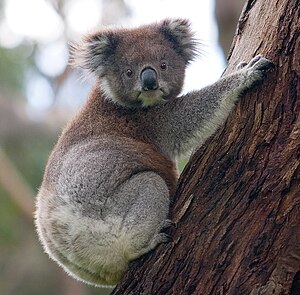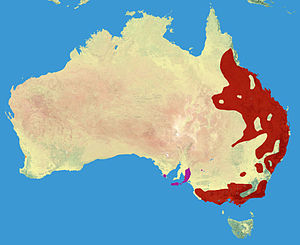Koala - Phascolarctos cinereus
| This page forms part of Project Species and considered an phase 2 article (started but not complete). Please consider adding more knowledge to this page. See Project Species for more information. |
The koala (Phascolarctos cinereus) or, sometimes inaccurately called, koala bear, is an arboreal herbivorous marsupial native to Australia. It is the only extant representative of the family Phascolarctidae and its closest living relatives are the wombats.

The koala is found in coastal areas of the mainland's eastern and southern regions, inhabiting Queensland, New South Wales, Victoria, and South Australia.

Koalas typically inhabit open Eucalyptus woodland, as the leaves of these trees make up most of their diet. This eucalypt diet has low nutritional and caloric content and contains toxins that deter most other mammals from feeding on it. Koalas are largely sedentary and sleep up to twenty hours a day. They are asocial animals, and bonding exists only between mothers and dependent offspring. Adult males communicate with loud bellows that intimidate rivals and attract mates. Males mark their presence with secretions from scent glands located on their chests. Being marsupials, koalas give birth to underdeveloped young that crawl into their mothers' pouches, where they stay for the first six to seven months of their lives. These young koalas, known as joeys, are fully weaned around a year old. Koalas have few natural predators and parasites, but are threatened by various pathogens, such as Chlamydiaceae bacteria and koala retrovirus.
Basic description
Koalas are marsupials that live in Australia. They have dense fur, round bodies, fluffy ears, and large oval-shaped noses. Their fur is usually grey or grey-brown in colour, and their undersides are lighter than their backs.
Anatomy
The koala is easily recognisable by its stout, tailless body and large head with round, fluffy ears and large, spoon-shaped nose. The koala has a body length of 60–85 cm (24–33 in) and weighs 4–15 kg (9–33 lb). Fur colour ranges from silver grey to chocolate brown.
Koalas from the northern populations are typically smaller and lighter in colour than their counterparts further south. These populations possibly are separate subspecies, but this is disputed.
Threats to the Koala population
The koala has suffered dramatic population declines as a result of habitat loss and fragmentation, disease, vehicle collision mortality, dog attacks, bushfires and climate change. In 2012, koalas were officially declared vulnerable by the Australian government and listed as a threatened species.
Among the many threats to their existence are habitat destruction caused by agriculture, urbanisation, droughts, and associated bushfires, some related to climate change. In February of 2022, the koala was officially listed as endangered in the Australian Capital Territory, New South Wales, and Queensland.
Chlamydia
Chlamydia is a bacterial infection that affects both humans and animals, including koalas. In koalas, it can cause conjunctivitis (eye inflammation), leading to blindness, bladder infections, and infertility due to cysts in the reproductive tract.[1] It is spread through contact between individuals or contaminated food sources such as pap (a eucalyptus leaf).[1]
Chlamydia in koalas is caused by two kinds of bacteria, Chlamydia pecorum and C. pneumoniae, which are different from the bacteria that usually causes the disease in humans. However, the latter could theoretically make humans sick if an infected koala urinates on them.[2]
Surveys have shown that some wild populations demonstrate a 100 percent rate of infection,[3] which frequently leads to blindness, severe bladder inflammation, infertility and death. And treatment with antibiotics could create further problems for the marsupials, upsetting their gut microbes and making it difficult for them to digest the eucalyptus leaves that are a staple of their diet.
Another study investigated the prevalence of Chlamydia pecorum infection and disease in 160 koalas in a peri-urban wild population in Queensland, Australia and found that 31% of koalas were Chlamydia PCR positive and 28% had clinically detectable chlamydial disease.[4]
Vaccination programmes
See also
External links
- Koala Wikipedia
References
- ↑ 1.0 1.1 Koala Chlamydia STD Check (cannot be archived)
- ↑ Archived:Australia Begins Vaccinating Hundreds of Koalas Against Chlamydia in New Trial Smithsonian Magazine
- ↑ Archived: Why the Heck Do So Many Koalas Have Chlamydia? Live Science
- ↑ Archived: Epidemiology of chlamydial infection and disease in a free-ranging koala (Phascolarctos cinereus) population Plos One